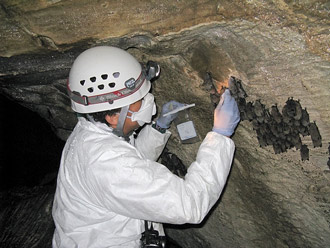 Wisconsin researchers have confirmed that Geomyces destructans, the fungus that causes white nose syndrome (WNS) in bats, persists in caves long after all the bats in the cave have died off.
Wisconsin researchers have confirmed that Geomyces destructans, the fungus that causes white nose syndrome (WNS) in bats, persists in caves long after all the bats in the cave have died off.
A paper published ahead of print in Applied and Environmental Microbiology also says that because the fungus has been found in all the caves that have had WNS outbreaks, but is not found in caves beyond the region where WNS has been found, the findings support the hypothesis that the fungus is an exotic species in North America.
The paper is particularly bad news in light of recent reports of bats repopulating caves where WNS had struck years ago.
A University of Wisconsin-Madison press release offers one tiny bit of good news. Bats that hibernate in near-freezing conditions seem to fare better than bats hibernating in conditions a few degrees warmer. David Blehert, a microbiologist at the U.S. Geological Survey National Wildlife Health Center in Madison and a lead researcher on the paper, says that the fungus grows much slower at those low temperatures.
Read the abstract in Applied and Environmental Microbiology. (The full article requires a subscription or fee.)Read the University of Wisconsin press release here.
Photo: A biologist takes samples from a cave in an early attempt to determine the cause of the deadly white-nose syndrome in hibernating bats. Courtesy of USGS National Wildlife Health Center
